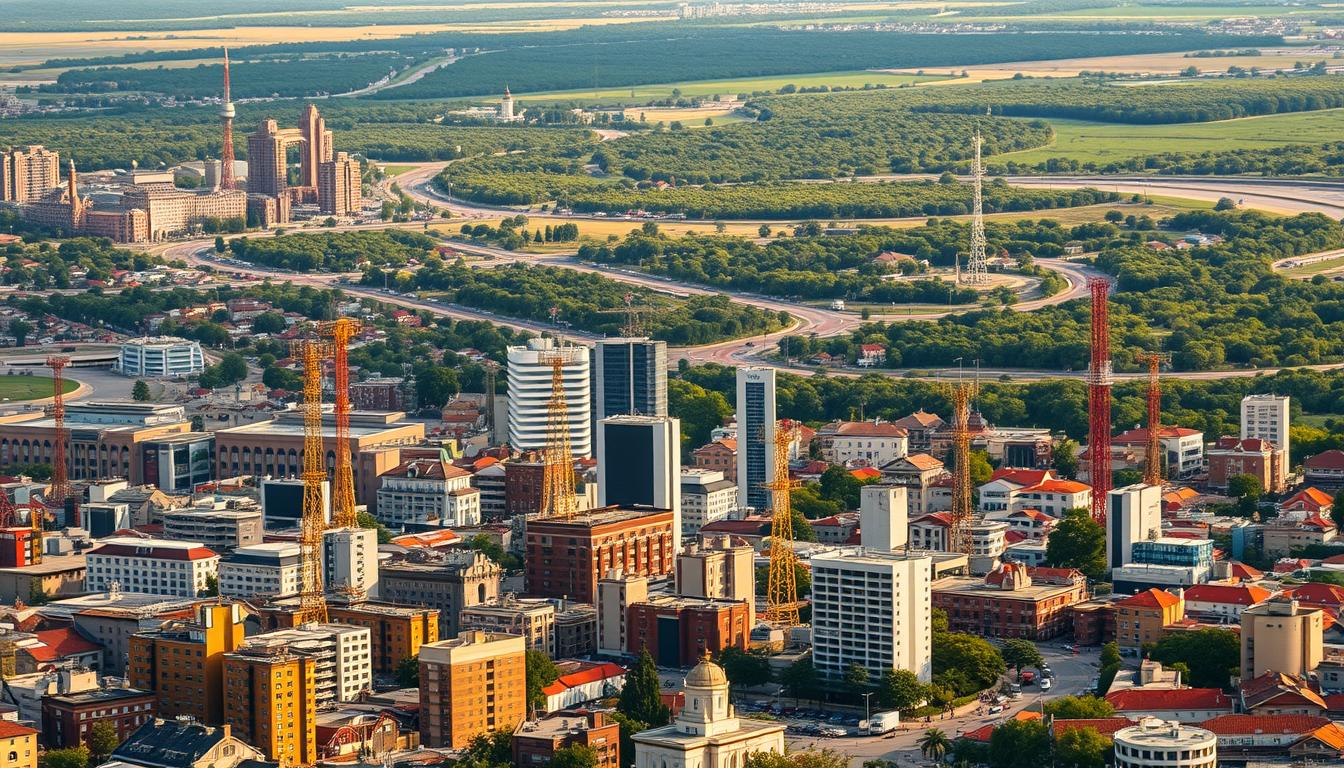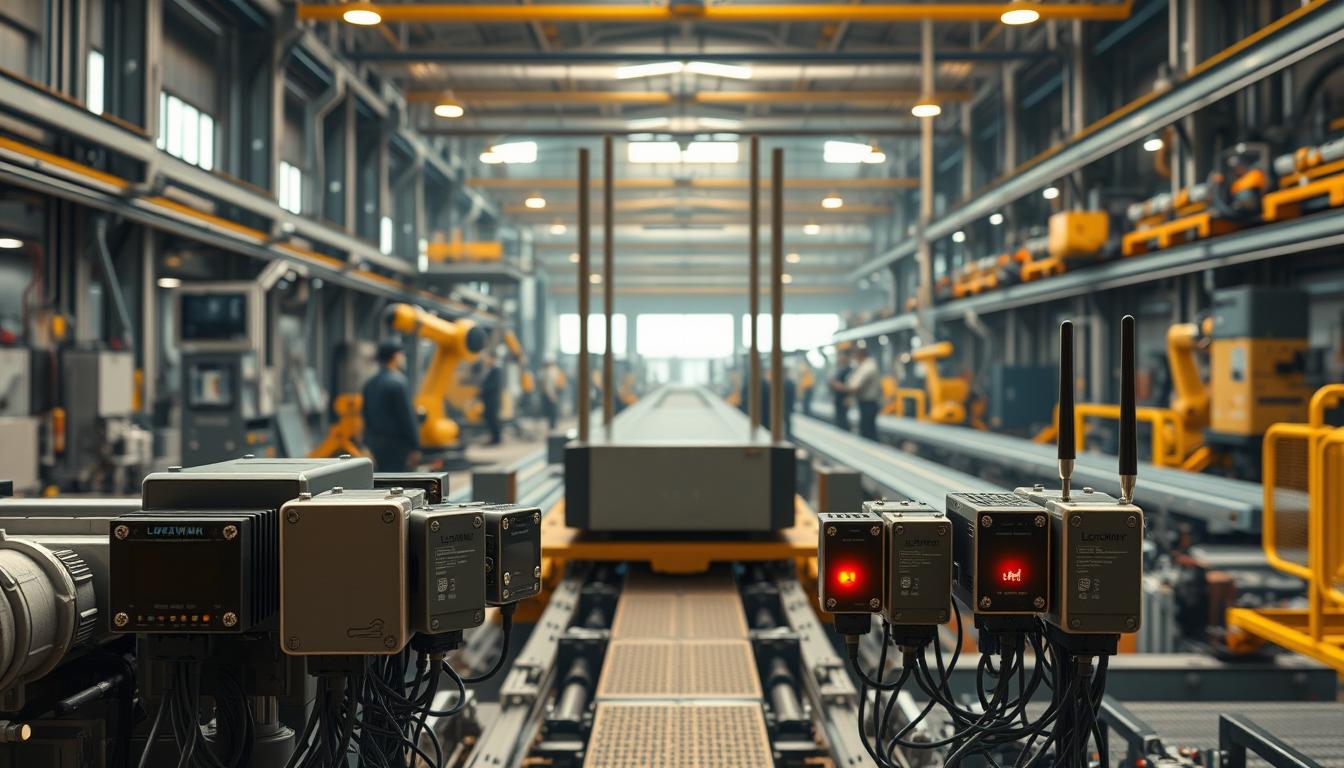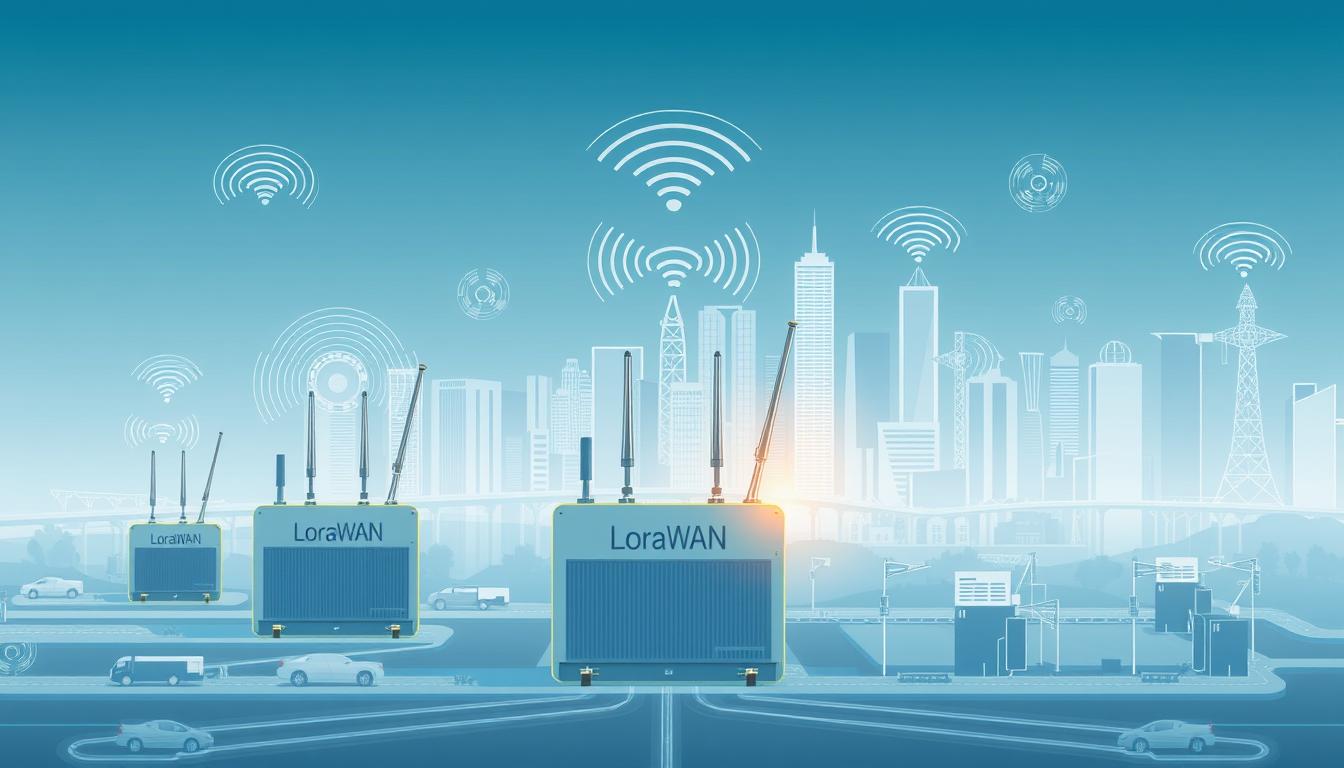LoRaWAN: the connected IoT network in France
The Internet of Things (IoT) is evolving rapidly in France, with LoRaWAN at the heart of this transformation. Thanks to its extended reach, this network is revolutionizing infrastructure management and performance optimization. Syscom-Prorep, a pioneer in this field, offers LoRaWAN connectivity solutions to meet today's challenges.
LoRaWAN, a wireless protocol, stands out for its ability to link objects over vast distances, while minimizing energy consumption. In France, it operates on the 868 MHz band, enabling communication up to 15 km between devices and the receiving antenna.
Thanks to its energy efficiency, LoRaWAN is an ideal solution for long-term applications, without the need for frequent battery changes. Its low cost and ability to transmit small amounts of data over long distances make it highly attractive.
In France, LoRaWAN adoption is growing rapidly. Orange Business, a major player, has announced the extension of its LoRaWAN network beyond 2027. This expansion testifies to the growing importance of this technology. With 36.4 million connected objects worldwide, including 16.4 million in France, Orange demonstrates the scale of this IoT revolution.
Key points to remember
- LoRaWAN uses the 868 MHz band in France
- Transmission range up to 15 km
- High energy efficiency for sustainable deployment
- Cost-effective solution for long-distance data transmission
- Used in intelligent logistics and asset tracking
- Significant network expansion by Orange Business in France
- Deployed in 162 countries with 181 operators
Understanding LoRaWAN technology and how it works
LoRaWAN technology transforms machine-to-machine communication for connected objects. Created in 2012, this French innovation represents a major breakthrough for the LPWAN protocol.
Definition and fundamental principles
LoRaWAN is based on Chirp Spread Spectrum modulation, guaranteeing long-range, interference-resistant communication. This LPWAN protocol excels in secure data transmission over long distances, while consuming very little energy.
LoRaWAN network architecture
The LoRaWAN network adopts a star-like structure. Connected objects communicate via gateways, which transmit information to a central server. This architecture enables :
- Multiple message reception by different gateways
- Equipment geolocation
- Efficient management of energy consumption
Technical specifications and frequency bands
LoRaWAN uses free ISM bands, such as 868 MHz in Europe. Equipment is classified into three categories (A, B, C) according to its communication and energy requirements. This flexibility makes LoRaWAN suitable for a variety of sectors: smart cities, environmental monitoring, healthcare and logistics.
IoT benefits of the Lorawan network
The LoRaWAN network offers a host of advantages for the Internet of Things. Its extensive transmission capacity enables efficient communication, reaching distances of up to 15 km in rural areas and several kilometers in urban areas. Thanks to their remarkable autonomy, wireless devices can operate for up to 10 years, depending on their use.

LoRaWAN's capacity for growth is impressive. A single gateway can manage thousands of IoT devices. Deployment is facilitated by the use of license-free radio frequencies. Security is enhanced by AES encryption and OTAA authentication.
LoRaWAN is the ideal choice for telemetry. Its low radiation and low power consumption make it a perfect choice for smart metering and water networks. Sensors manufactured in France by Enless Wireless ensure regulatory compliance.
Syscom-Prorep offers versatile LoRaWAN solutions, compatible with GNSS, Wi-Fi and Bluetooth. This flexibility enables the creation of tailor-made IoT projects, precisely meeting the specific needs of each customer.
Deployment and infrastructure in France
France is seeing an acceleration in IoT deployment thanks to long-range networks, in particular LoRaWAN. This technology, created in France in 2009, provides extensive coverage. It reaches 3 to 8 km in urban areas and up to 20 km in rural areas.
National network coverage
LoRaWAN network coverage in France is expanding rapidly. Orange Business, a key player, has assured the continuity of its infrastructure beyond 2027. Netmore, a newcomer, began deployment in 2023. It is aiming for nationwide coverage for large-scale IoT projects.

Operators and service providers
Several operators offer LoRaWAN services in France. Orange Business and Netmore stand out for their commitment to network development. They are working with strategic partners to enhance the service offering. This facilitates IoT adoption.
Installation and set-up
LoRaWAN's star architecture simplifies infrastructure deployment. Gateways connect devices to the network core, facilitating flexible, cost-effective installation. Projects such as ROC42 by SIEL-Territoire d'énergie Loire illustrate the effectiveness of LoRaWAN. They highlight its applications for smart cities and energy management.
Practical applications in smart cities
The Internet of Things, thanks to the LoRaWAN network, is revolutionizing our urban agglomerations. This technology is transforming urban centers into truly connected cities. It offers residents a host of innovative services.
Intelligent street lighting is a perfect illustration of this trend. In Barcelona, a lighting system using LoRaWAN has reduced energy consumption by 30%. In the Eixample district, streetlights adjust their brightness according to the presence of pedestrians. This limits energy wastage.
Waste management is also benefiting from this revolution. LoRaWAN sensors installed in waste garbage cans alert collection services when they are full. This system optimizes rounds and reduces collection costs.
Public transport is no exception. In London, a machine-to-machine communication network based on LoRaWAN enables buses and subways to be tracked in real time. This innovation improves service quality and reduces delays.
Finally, smart meters for water, gas and electricity are on the increase. In Kaunas, Lithuania, these connected objects enable precise monitoring of consumption. This reduces waste and cuts bills for local residents.
Solutions for industry and the professional sector
The LoRaWAN LPWAN protocol is transforming the industrial sector with innovative solutions. It enables optimal equipment management, meticulous infrastructure monitoring and process improvement. This technology ensures long-range connectivity, while consuming little energy. It is therefore ideal for large-scale IoT applications.
Industrial equipment management
LoRaWAN facilitates the efficient management of industrial equipment. It uses telemetry and wireless sensors to monitor machine performance. This enables companies to plan maintenance and reduce downtime. Syscom-Prorep offers embedded systems, such as industrial PCs and SoMs, adapted to these demanding environments.

Infrastructure monitoring
LoRaWAN technology enables large-scale monitoring of urban and industrial infrastructures. It measures parameters such as temperature, humidity and air quality. This continuous monitoring enhances safety and enables predictive maintenance, thereby reducing operating costs.
Process optimization
LoRaWAN optimizes industrial processes by providing precise, real-time data. In logistics, for example, it is used to monitor transport conditions. LoRaWAN sensors transmit temperature data, ensuring product quality throughout the journey.
Thanks to its extended range and low energy consumption, LoRaWAN is the solution of choice for Industry 4.0. It offers reliable, secure connectivity for professional IoT applications.
LoRaWAN network security and reliability
The LoRaWAN network stands out for its robust security and reliability, essential for successful IoT deployment. This technology offers secure m2m communication thanks to its advanced architecture.
Security protocols
LoRaWAN integrates a network layer dedicated to managing communication and authentication. Spread spectrum technology ensures secure, efficient data transmission. Bi-directional communication enhances the reliability of information exchanges.
Data management
Lorawan excels in data management. It enables efficient transmission with minimal energy consumption. Connected devices can operate for up to 10 years on a single battery, guaranteeing long-term reliability.
Regulatory compliance
The LoRa Alliance oversees a rigorous certification program. It offers real-time monitoring services, reinforcing network security and compliance. This approach ensures that iot deployment complies with current standards.
The reliability of the LoRaWAN network is enhanced by its extensive coverage. In France, the Orange network covers 95% of the population. Its transmission range reaches 20 km, ensuring reliable connectivity even in difficult environments such as basements.
Comparison with other IoT technologies
Long-range networks, such as LoRaWAN, are distinguished by their unique characteristics. They offer an impressive range, from 5 to 15 km per gateway. This exceeds the range of NB-IoT cellular stations, which only cover 2 to 3 km. This capability makes LoRaWAN ideal for rural and remote areas.
When it comes to energy consumption, LoRaWAN excels. Its devices can run for up to 10 years on a single battery. This contrasts with other LPWAN protocols, which require more frequent battery changes. This energy efficiency is essential for large-scale deployments.
LoRaWAN's data rate is 50 kbps, lower than NB-IoT's 200 kbps. However, LoRaWAN stands out for its deployment flexibility. It enables the creation of localized private networks, unlike NB-IoT, which depends on existing 4G/LTE infrastructure.
For applications requiring long range, deep penetration and low power consumption, LoRaWAN is preferable. NB-IoT is better suited to scenarios requiring high-speed connectivity and extensive coverage. The choice between these technologies depends on the specific needs of each IoT project.
Future prospects and innovations
The LoRaWAN network paves the way for many innovations in the Internet of Things. Technological advances and market expansion promise an exciting future for connected objects.
New functions
Remote Connected Object Update (FUOTA) revolutionizes the management of IoT devices. This feature optimizes the performance and security of LoRaWAN sensors without physical intervention.
Technological developments
The integration of LoRaWAN with non-terrestrial networks (NTN) and the development of LR-FHSS technology improve connectivity for large-scale IoT deployments. These advances extend the reach and reliability of the lorawan network.
Market expansion
The LoRaWAN sensor market is experiencing significant growth. Environmental monitoring, intelligent agriculture and connected buildings are driving this expansion. Key players such as Ellenex, Radio Bridge and Milesight are contributing to innovation in this field.
ZENNER's successful deployment of 7.5 million sensors in 15 countries demonstrates the scalability of the lorawan network. Reduced deployment costs and rapid return on investment are encouraging the adoption of this technology in a variety of sectors.
The LoRa Alliance is working on improving scalability and device certification. These efforts aim to strengthen the Internet of Things ecosystem and open up new prospects for connected objects.
Conclusion
France is experiencing a revolution with the introduction of LoRaWAN technology in IoT deployment. Thanks to its 15 km range in rural areas, this network ensures robust connectivity. It also enables remarkable device autonomy, making M2M communication simpler. Thousands of sensors can operate through a single gateway.
LoRaWAN stands out for its energy efficiency, enabling devices to last up to 10 years on a single battery. This longevity, combined with its easy integration into existing infrastructures, makes it a preferred choice for smart cities and industry. French companies such as BTIB already offer a variety of compatible sensors, illustrating local support for this technology.
The worldwide deployment of over two million LoRa gateways and the forecast of 225 million devices by 2024 underline the importance of LoRaWAN. Its star architecture simplifies deployment and reduces costs. Advanced monitoring and control capabilities pave the way for complex IoT applications in a variety of sectors. To find out more about IoT deployment and LoRaWAN solutions, contact us on +33 1 60 86 80.
FAQ
What is LoRaWAN and how does it work?
LoRaWAN is a long-range communication protocol for the Internet of Things (IoT). It uses LoRa technology to transmit data over long distances with low energy consumption. The network consists of connected objects, gateways and a central server, enabling efficient communication between devices and applications.
What are the main advantages of LoRaWAN for the IoT?
LoRaWAN offers several key advantages: long range (up to several kilometers), low power consumption (enabling years of autonomy for sensors), low infrastructure costs, and high device connection capacity. These characteristics make it an ideal solution for many IoT applications, particularly in smart cities and industry.
How is the LoRaWAN network being rolled out in France?
LoRaWAN is being deployed in France by national operators such as Orange Business and specialized service providers. Coverage is gradually expanding, with an initial concentration in urban and industrial areas. Installation can be carried out by specialist companies such as Syscom-Prorep, who offer tailor-made solutions for network deployment and management.
What are the concrete applications of LoRaWAN in smart cities?
In smart cities, LoRaWAN enables numerous applications such as connected street lighting, smart parking, waste management, air quality monitoring and water management. These solutions use wireless sensors to collect data in real time, optimizing urban management and improving citizens' quality of life.
How is LoRaWAN used in industry?
In industry, LoRaWAN facilitates equipment management via telemetry, infrastructure monitoring for predictive maintenance, and process optimization such as cold chain monitoring. LoRaWAN sensors can be deployed on a large scale to collect crucial data, improving operational efficiency and reducing costs.
Is LoRaWAN secure for sensitive communications?
Yes, LoRaWAN incorporates robust security protocols, including double-level encryption to protect communications. Data management is secure, guaranteeing the integrity and confidentiality of transmitted information. What's more, LoRaWAN complies with current regulations, making it a reliable solution for sensitive communications.
How does LoRaWAN compare with other IoT technologies?
Compared with other IoT technologies, LoRaWAN stands out for its long range and low power consumption. It is particularly well suited to applications requiring extensive coverage and long sensor autonomy. However, for applications requiring higher data rates, other technologies such as Wi-Fi or 5G may be more appropriate.
What are the future prospects for LoRaWAN?
The future of LoRaWAN is bright, with innovations such as the FUOTA remote connected object upgrade. The market is expected to expand into new sectors and regions. Future technological developments should further enhance LoRaWAN's capabilities, paving the way for innovative new IoT applications.
What is the typical range of a LoRaWAN network?
The range of a LoRaWAN network can reach several kilometers in urban areas and up to 15 km in rural areas. This long range makes it possible to cover vast areas with a limited number of gateways, making LoRaWAN particularly effective for large-scale IoT deployments.
How does LoRaWAN contribute to the energy efficiency of connected objects?
LoRaWAN uses a spread-spectrum modulation technology that enables devices to communicate with very low power consumption. This, combined with optimized protocols, enables LoRaWAN sensors to operate for several years on a single battery, reducing maintenance costs and environmental impact.

